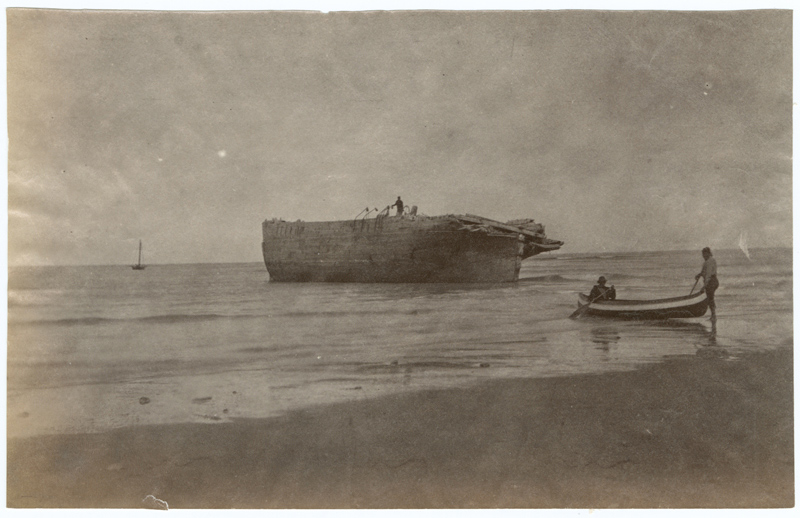Visit this blog for regular posts about Your Archives: The Histories We Share. Visit the Archives of Manitoba to see the records in person.
August 2021:
August 27, 2021
Two photographs of the wreck of the HBC ship Cam Owen taken in 1889 by James McDougall, HBC post inspector – Submitted by Jean-Luc Pilon, Former curator of Central Archaeology, Canadian Museum of History
“In the early 1980s, I carried out archaeological research along the Severn River in northwestern-most Ontario. At that time, I was told about shipwrecks lying to the northwest of Fort Severn, in the direction of the Manitoba border. My interest then was focused on the region’s Indigenous ancient history and so I never visited those wrecks. However, in 2017 I had the opportunity of returning to Fort Severn. This time, the omnipresence of ATVs allowed us to travel to a half dozen wreck sites along the coast. Three of these appeared to consist of sections of the same wooden-hulled sailing ship. These three sites were sprinkled along a two-kilometer stretch of the same raised beach, which is today over one kilometer from the shore of Hudson Bay. Preliminary observations suggested it dated to the second half of the 19th century.

enlarge image
![Deck view of the wreck [of Cam Owen]](../../images/2021/2021-08-27_full_02.jpg)
enlarge image

enlarge image
full size
“Anthony Dalton published a compilation of HBC shipwrecks in 2014, The Fur-Trade Fleet: Shipwrecks of the Hudson’s Bay Company. His work helped me narrow my search for the identity of the ship and the best candidate to emerge was the Cam Owen. This twin-masted brigantine was one of the rare Canadian-built ships in the HBC fleet, built in Prince Edward Island in 1883. It met its end a mere three years later during a violent storm near Cape Churchill, Manitoba, and according to Dalton’s research, ‘the ice carried her away to a private burial at sea’. That, it would seem, was that. However, a search through the online HBC Archives produced an incredible find: two photographs (HBCA 1987/13/043 and HBCA 1987/13/044) identified as the wreck of the Cam Owen taken by James McDougall in 1889 while travelling from York Factory to Fort Severn. The clearly visible, bent iron chainplates (to which the masts are tied off) in McDougall’s photographs are identical to those of the wrecks I visited. Most importantly, McDougall noted that the wreck was near ‘Sandy Head, Hudsons Bay’.
“In the fall of 2017, I spent an afternoon with the late John Macfie, a former Ontario Lands and Forest employee, who photographed two of the ship hulls in 1955 while banding migratory waterfowl. At one point he showed me a picture of a low hill that he told me was called Oosteguanako or Oostegwan-aski meaning ‘Sand Head’. In Macfie’s opinion this name reflected the shape of the sand hill or dune. This elevated land feature, so rare in the very, very flat lowlands adjacent to Hudson Bay, was located just a few miles to the northwest of the ship hull wrecks and the place name seems closely related to the one McDougall noted in his 1889 photograph catalogue entry. Chris Koostachin of Fort Severn, who brought me to see the wrecks in 2017, informed me that there is a hill near East Pen Island is called Ooshdikwanahkahk, meaning ‘beach with skulls’ and it is believed to attest to a battle which once took place near East Pen Island.
“Had McDougall never taken those two photographs and had he not noted the local place name, the identity of the ship would never have been firmly determined. While the vessel did not serve the HBC for very long, it nonetheless was part of the history of the Hudson’s Bay Company, the fur trade, and Canadian shipbuilding. Located as it is far from the edge of Hudson Bay, it is also a witness to the dynamic and changing landscape of the Hudson Bay Lowlands which continue to this day to rebound from the incredible weight of the glaciers of the last ice age which ended more than 10,000 years ago but whose effects are still felt in these remote and distant lands.”
Want to know more? Search Keystone for more information. You can also Visit Us in person at the Archives of Manitoba.
Want to participate in Your Archives? See Submit Your Story for details. You may e-mail us at yourarchives@gov.mb.ca with a comment about this blog post and your comments may be included on this page.



